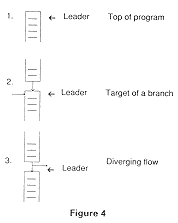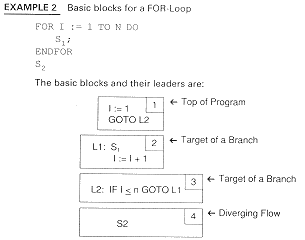8.5.1 Basic Blocks

Leaders
A basic block consists of a leader and all code before the next leader. We define a leader to be (1) the first statement in the program (or procedure), (2) the target of a branch, identified most easily because it has a label, and (3) the statement after a "diverging flow " : the statement after a conditional or unconditional branch. Figure 4 shows this pictorially:

Since a basic block consists of straight-line code, it computes a set of expressions. Many optimizations are really transformations applied to basic blocks and to sequences of basic blocks.

Although this program might be translated in different ways, the discussion here is still valid.
One we have computed basic blocks, we can create the control flow graph.
